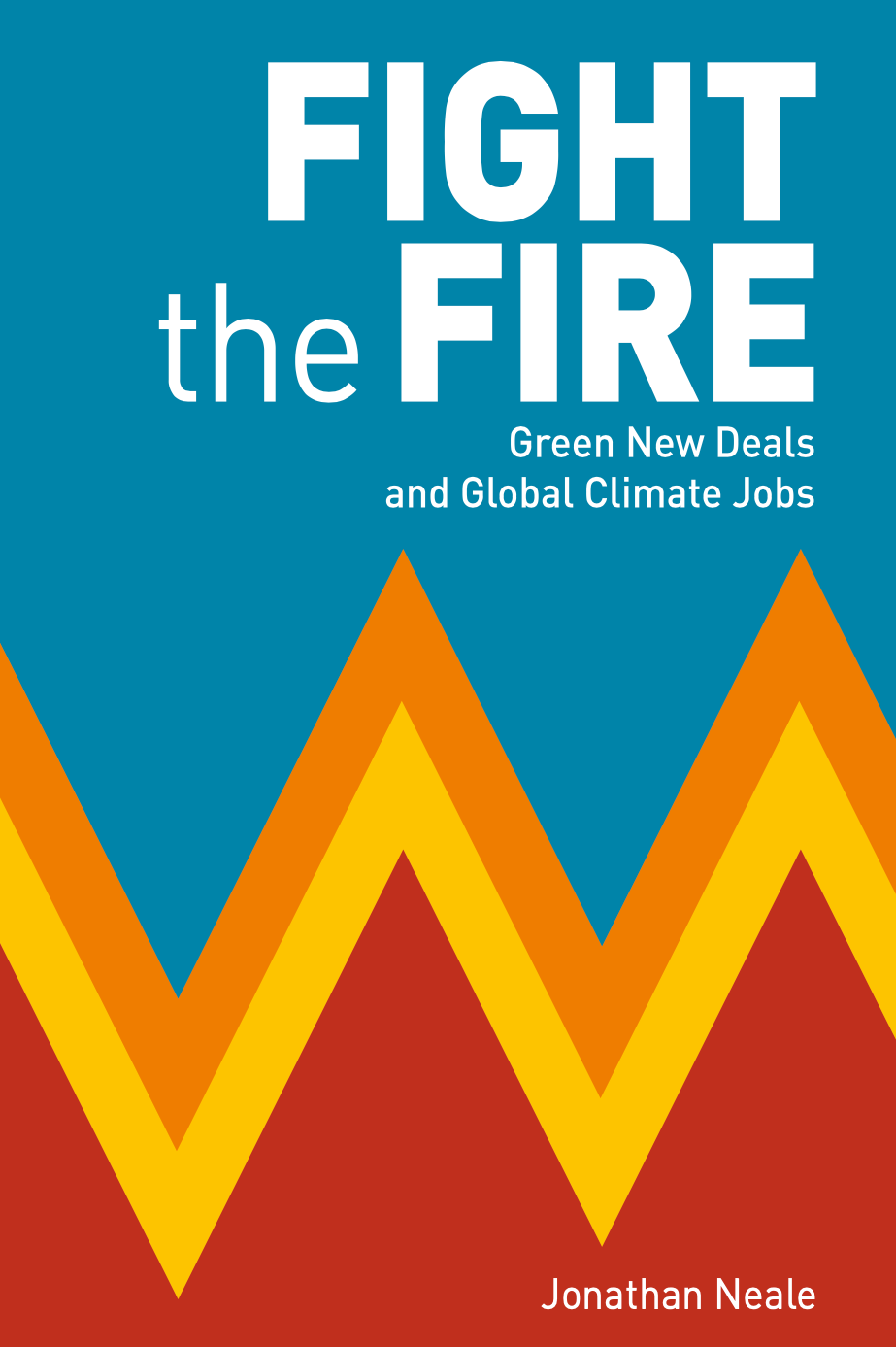
JONATHAN NEALE
This article is an excerpt from Jonathan Neale’s important new book Fight the Fire: Green New Deals and Global Climate Jobs. You can download a pdf or an e-book for FREE here, or order a paperback here.

The falls in the price of solar and wind power have been dramatic. Does this mean the the market will now produce enough renewable energy?
Unfortunately, no.
We have been told for two decades that the proportion of renewable energy in total global energy has been continually rising. But in fact, in 2019 wind and solar produced less than 2% of the total energy used globally. Less than 2%.
That proportion of 2% has not been growing. For the last four years, the amount of new wind and solar each year has been flat, and not increasing. That means that total investment has actually been falling. (If solar is cheaper, lower investment can still produce the same amount of solar.)
On the face of it, this makes no sense. Surely, if the price of wind and solar is falling, they should be replacing fossil fuels. And the cheaper they get, the more corporations should be investing. In fact, the opposite is happening. The market is failing. This article explains why, and what we can do about it.[1]
The Statistics
The statistics on renewable energy are usually presented in ways that are confusing. Let me show you how that works, and how to think clearly about the numbers.
I start with the statistics for renewable energy in the European Union. The statistics for renewable energy are usually presented as a percentage of capacity. In 2018, for example, 17% of installed capacity for electricity generation in the EU came from wind power. And 11% of installed capacity came from solar PV. That’s a total of 28% from wind and solar. That’s pretty good.
But that is a measure of “installed capacity”. Capacity means the amount of electricity a wind turbine is capable of producing if the wind blows at maximum speed 24 hours a day every day. For solar PV, capacity means the amount of electricity a solar array can produce if the sun shines without clouds 24 hours a day every day of the year.
But most of the time the wind does not blow at the highest speed the turbine can handle. And the sun does not shine at night.
In practice, a wind turbine is doing well if it provides 35% of its maximum capacity over the whole year. A solar PV array is doing well if it provides 20% of its maximum capacity over one year.
By contrast, natural gas usually achieves about 60% of capacity. Coal achieves almost 80%.
What this means is never pay attention to statistics about capacity. The statistics you want are the ones for electricity production – the amount of electricity generated over a year. If you look at those statistics for the EU in 2019, wind accounted for 11% of electricity generation, and solar accounted for 4%. So that’s a total of 15% of electricity generation. That’s about half of the figure for capacity.
However, these are statistics for electricity generation. Sometimes it is called energy generation. Sometimes it is called power. But it means electricity and only electricity. The statistics do not include the oil, coal and gas burned in transport, in industry, and in buildings. But only about 40% of total energy use in the EU goes into electricity. That means that wind and solar account for about 6% of total energy in the EU. Not so good.
But the rest of the world is worse than the EU. The global figures are measured in terawatt hours. One terawatt hour is one billion kilowatt hours. As you will see, world-wide total energy use is 159 thousand terawatt hours. Wind and solar combined produce 2 thousand terawatt hours, less than 2% of total energy use. See the following table:
Global energy in 2018 in 2018 in 1,000 terawatt hours
Oil 54
Coal 44
Gas 39
Traditional biomass 11
Hydropower 4
Nuclear 3
Biofuels 2
Wind 1.4
Solar 0.7
TOTAL 159 thousand terrawatt hours
[“Traditional biomass” mostly means burning wood, but also includes burning leaves, crop residue and cow dung.] [2]
But it is very rare that you see the statistics that show wind and solar combined produce less than 2% of global energy. What you will see instead is a statistic for “renewables.” You might think that renewables means wind and solar. It does not. It usually includes biomass, hydropower, nuclear power and biofuels. Let’s look at those numbers again:
“Renewables” in 2018 in thousands of terawatt hours
Traditional biomass 11
Hydropower 4
Nuclear 3
Biofuels 2
Wind 1.4
Solar 0.7
TOTAL 22
In that calculation, half of the renewables are from burning wood and other traditional biomass. About 10% are from wind and solar combined.
Let’s look at those statistics again as a bar chart.
Bar Chart: Global Energy Use
Coal, oil and gas 137
Other Renewables 20
Wind and solar 2
Moreover, as we have seen, there will not be large increases in biomass, biofuels, hydropower or nuclear. The two energy sources that are really capable of expanding are wind and solar. They will be the workforces of the transition to renewables.
You may be thinking, but wait a minute, what about all those times when the news says that on such and such a day 100% of energy in Germany came from renewables. Such statements are misleading for three reasons. The first is that they do not mean just wind and solar. Second, they don’t actually mean 100% of energy. They mean 100% of electricity. The third answer is that particular day was the sunniest and windiest in the last few months. They don’t mention the very much larger number of days when less than half of energy for electricity came from renewables.
In other words, the statistics are presented in ways that mislead you.
It should not be really surprising that there is so little wind and solar energy in the world. After all, CO2 emissions are going up globally. If we had really gone from tiny amounts of renewables to very large amounts of renewables, CO2 emissions would be going down.
Again, maybe you are thinking, hang on, in Europe there has been a real growth in renewables, and there have been real falls in emissions. The same is true in the United States. And you’re right. But most of the falls in emissions are coming from a switch from burning coal in electrical power stations to burning natural gas. Coal has about twice the emissions compared to gas for the same quantity of electricity. That shift has been marked in the European Union and North America, and it has had a much larger effect than the growth in renewables.
I can hear some of you thinking, this is weird. This is beginning to sound like a conspiracy theory about the lizard people trying to kill Donald Trump. Why is Jonathan saying one thing, and almost all the sources I read are saying the opposite?
There is more than one answer, because more than one group of people have good reason to exaggerate the amount of wind and solar. The oil and gas companies have obvious reasons. Just look at the ads they do on television and social media about how much renewable energy they are building. They want us to believe they are solving the problem.
The politicians and governments want the same thing. They do not want to us to believe they are failing.
The people who work in the renewable industry, and the people who own it, want everyone to know the industry is doing well. And because there are a much larger number of people, the rest of us, who desperately want to see more renewable energy to save the planet, we want to believe what they are telling us. But the figures are clear enough.
So what’s gone wrong? And how can we fix it?
What Went Wrong
Sean Sweeney and John Treat at Trade Unions for Energy Democracy (TUED) have explained what’s gone wrong in a series of brilliant reports. Sweeney is a professor at the City University of New York. He is also the director of TUED, which is an alliance of trade unions from all over the world concerned with climate change and public sector energy industries. [3]
Sweeney and Treat’s explanation for what has happened is convincing. It goes like this:
Until 2016, the amount of wind and solar power globally was steadily increasing. But that amount started from a very small base. At the same time, the global demand for energy was increasing rapidly. As more wind and solar was coming onstream, so were large amounts of fossil fuels. In particular, there have been large rises in the amount of fracked gas in North America. So while wind and solar have indeed increased, it remains a small proportion of the total because fossil fuels are increasing too.
Bar Chart: Net capacity added in main generation technologies, 2009-2019 in GWs
Coal 529
Gas 438
Hydro 283
Wind 487
Solar 638 [4]
There was almost no net change in oil and nuclear for electricity generation.
But notice that these are figures for capacity added. Because wind and solar give you far less power for your capacity, these figures in fact show that the share of fossil fuels in electricity generated increased over the last decade.
And these are only the figures for electricity generation. The rise in use of oil in transport and gas in industry mean that the share of wind and solar in total energy use has fallen even more.
Then, starting in 2016, the amount of private investment in wind and solar began to decline. This was, oddly enough, a result of the falling price of wind, and in particular the falling price of solar. This seems strange, but Sweeney and Treat explain why that has happened.
Until 2016, almost all wind and solar investment happened because of subsidies. Most of the subsidies were in the European Union, and most of them took the form of “feed-in tariffs.” This meant that people or companies with wind or solar were promised a guaranteed high price by the electricity company for the power they provided. This subsidy was not paid by the government. Instead, the electricity company raised money for the subsidy by charging more to customers without wind or solar power. This was a political bomb waiting to go off. It was also a system that could only be tolerated as long as wind and solar were a small part of total supply.
Then the price of wind, and particularly, solar fell. The renewables industry began to say that solar was as cheap as coal, and maybe even cheaper. Wind, they said, was cheaper than gas. They were probably exaggerating a bit, but not by much. At that point the governments in Europe abolished the feed-in tariffs. Reasonably enough, they said there was no point in other customers subsidizing something that was already cheap.
Instead, renewable companies had to bid for contracts to supply electricity to the grid. The renewable company that put in the lowest bid would bet the contract in each case.
The result was a deep cut in profits for the renewables corporations. They had been having fat contracts with guaranteed profit margins. And those margins could only get better as the technology got cheaper. Now they had to put in the lowest bid, which shaved their profit to the bone.
Companies had enjoyed guaranteed healthy profits. Now they faced narrow margins and low profits. Not surprisingly, many companies stopped investing.
The subsidies were cut first in the European Union. Quite quickly, they were cut in the United States as well. The same process is being repeated in China. In 2018 China had a reputation for massive development of renewables. In fact, wind accounted for 5.2% of electricity generation that year, and solar for 2.6%. That is a total of 7.8%, and that is only for electricity.
But then the Chinese government began withdrawing support for wind and solar. Michael Standaert, a knowledgeable journalist covering Chinese tech and energy, wrote in Yale Environment 360 in September, 2019:
Important roadblocks have recently slowed the nation’s green energy transition, following several years when emissions had plateaued. Although major solar and wind power installations in China’s more far-flung provinces can produce large amounts of renewable energy, a lack of high-voltage transmission infrastructure means that a sizeable percentage of the green energy goes unused.
In addition, as renewable energy prices have fallen and the central government has grown increasingly concerned about the impact of the U.S.-China trade war on China’s economy, renewable subsidies are being phased out. Wind and solar facilities must now compete directly at auction with other forms of power generation…
While curtailing subsidies for wind and solar power, the central government has sharply increased financial support for it calls “new energy” extraction, which includes fracking of shale gas and separating methane from coal. Those subsidies are an important reason behind China’s rising CO2 emissions…
While new solar photovoltaic installations hit an all-time high of 53 gigawatts (GW) in 2017, they slipped to around 41 GW [in 2018]… Projections are for about 25 GW of solar power to be installed this year and in succeeding years through 2025, an amount that would not sharply curtail fossil fuel use.[5]
Which is an understatement.
The same thing has been happening in India. During the 2015 Paris talks, India’s government stated that it would install 175GW or renewable energy by 2022. However, India is not expected to reach more than 69GW by 2022, and renewable energy capacity fell to just 8GW during the 2018-2019 financial year. [6]
The problem is global. The rate of installation of new solar and wind has gone flat. That means that actual levels of investment must have declined.
Maybe this is a temporary stall in the market. Maybe it will right itself in five or ten years. I have my doubts, but it could happen. But the larger and more important fact is not the stalling of wind and solar. It is that headline number: After 30 years of effort all over the world, wind and solar provide less than 2% of global energy.
So, do we despair?
No.
All these problems with the market just mean that the market has not worked. We have given the market in renewables decades to work, and it has not. And indeed, why should it? Why should the market be the solution to the most acute problem humanity has ever faced?
This is another obvious reason we must have public sector, government run climate jobs programs producing renewable energy. Then those workers and those governments will not have to worry about profit margins. They can get on with the job that needs doing.
It’s an example of a more general point. When things go wrong, don’t despair. Fix the problem by doing something different.
Jonathan Neale is a writer and climate activist. On Twitter he is @JonahtanNealeA1. This is an excerpt from his book Fight the Fire: Green New Deals and Global Climate Jobs has just been published by The Ecologist magazine and Resistance Books. You can download a free pdf or a free e-book here, or order the paperback here.
[1] This chapter relies on the important work of Sean Sweeney and John Treat at Trade Unions for Energy Democracy. See Sean Sweeney and John Treat, 2017, Energy Transition: Are We “Winning”? TUED Working Paper 9; and Sean Sweeney and John Treat, 2017, Preparing a Public Pathway: Confronting the Investment Crisis in Renewable Energy, TUED Working Paper 10.
[2] Hannah Ritchie and Alex Rose, 2019, “Energy.” Our World in Data.
[3] Sweeney and Treat, “Energy transition” and “Public pathway”; Brian Ashley et al, 2020, Eskom Transformed: Achieving a Just Energy Transition for South Africa, Eskom Research Reference Group, 35-75.
[4] After figure 3 in Ashley et al, Eskom Transformed, 38.
[5] Michael Standaert, 2019, “Why China’s Renewable Energy Transition is Losing Momentum,” Yale Environment 360, Sept 26.
[6] Ashley at al, Eskom Transformed, 51.


Be the first to comment